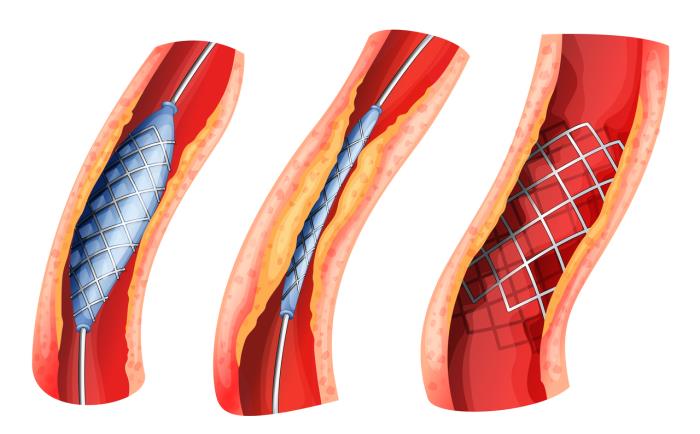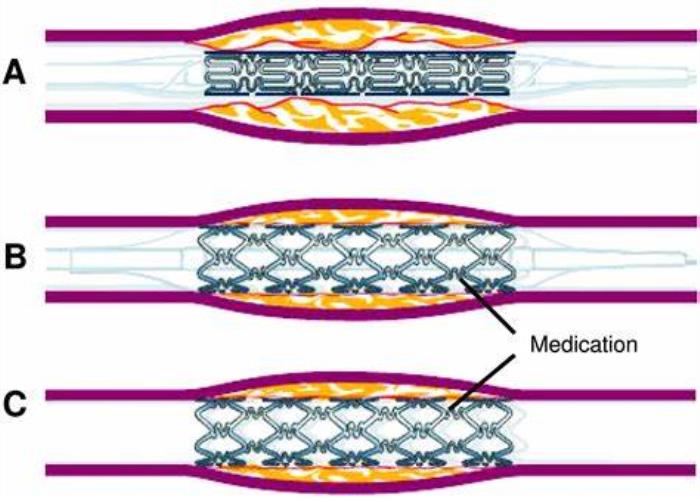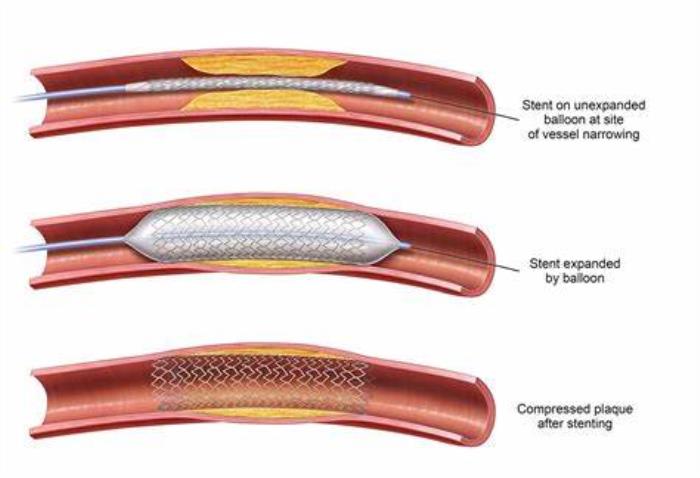Stents play a crucial role in angioplasty procedures by helping to keep narrowed or blocked arteries open after treatment. These small, mesh-like tubes are inserted into the artery during angioplasty to provide structural support, ensuring that blood can flow freely. The use of stents significantly enhances the effectiveness of angioplasty by reducing the likelihood of re-narrowing (reblockage) of the treated artery, thereby improving long-term outcomes for patients with coronary artery disease.
What is a Stent? A Brief Overview
A stent is a medical device made of metal or polymer materials that is inserted into a blood vessel or duct to keep it open. Typically designed as a tubular scaffold, stents are deployed during angioplasty procedures to maintain the patency of arteries after balloon dilation. They come in various designs and materials to meet the specific needs of individual patients and types of arterial blockages.
How Stents Work to Keep Arteries Open
Stents work by mechanically supporting the walls of the artery, preventing them from collapsing after the balloon used in angioplasty is deflated and removed. Once placed, the stent expands to fit the diameter of the artery, providing a scaffold that maintains blood flow. Over time, the artery may heal around the stent, integrating it into the arterial wall, which helps to further stabilize the artery and reduce the risk of future blockages.

Types of Stents Used in Angioplasty
There are several types of stents used in angioplasty, each designed for specific clinical scenarios and patient needs. The two primary categories are bare-metal stents and drug-eluting stents, with newer innovations like biodegradable stents also emerging. The choice of stent type depends on factors such as the location and severity of the blockage, as well as the patient’s overall health condition and risk factors.
Bare-Metal Stents: Basic Design and Applications
Bare-metal stents (BMS) are the simplest type of stent, made from stainless steel or cobalt-chromium alloys. They provide structural support without any additional coatings or drugs. BMS are typically used in cases where the risk of restenosis (re-narrowing of the artery) is lower or when a patient may not be able to use a drug-eluting stent due to medical reasons. While effective, bare-metal stents have a higher rate of restenosis compared to drug-eluting stents.
Drug-Eluting Stents: How They Help Prevent Reblockage
Drug-eluting stents (DES) are coated with medication that is slowly released to help prevent reblockage of the artery. The drugs used in DES target cell proliferation, reducing the likelihood of restenosis after angioplasty. These stents have been shown to significantly lower the rates of re-narrowing compared to bare-metal stents, making them a preferred choice for many patients, particularly those with a higher risk of restenosis due to complex lesions or multiple blockages.

Biodegradable Stents: Innovations and Advantages
Biodegradable stents represent an innovative advancement in vascular intervention. Made from materials that gradually dissolve over time, these stents provide temporary support to the artery while allowing it to heal naturally. As the stent biodegrades, it reduces the long-term risks associated with permanent implants, such as chronic inflammation or late restenosis. Biodegradable stents have shown promise in early studies, offering a potential alternative for patients seeking to minimize foreign material in their bodies while still benefiting from the structural support of a stent during the healing process.
Polymer-Coated vs. Non-Polymer-Coated Stents
Polymer-coated stents release medication over time to prevent restenosis (re-narrowing of the artery), while non-polymer-coated stents lack this feature. Understanding the differences helps healthcare providers select the appropriate option based on individual patient needs and risks.
Specialty Stents: Using Different Materials for Unique Needs
Specialty stents made from various materials, such as biodegradable polymers or metals, are designed for specific patient conditions. These innovations can improve compatibility with the body and reduce long-term complications.
Stent Delivery Systems: How They Are Placed
Stent delivery systems, which include balloon catheters, are used to accurately place stents in blocked arteries. These systems enable doctors to navigate through the vascular system and deploy the stent at the site of blockage.
The Importance of Stent Sizing and Selection
Choosing the right size of a stent is crucial for its effectiveness. A stent that fits improperly can lead to complications such as restenosis or stent thrombosis, emphasizing the need for precise measurement and selection.
Evaluating Stent Performance: Success Rates and Risks
Stent performance is assessed through success rates and risks of complications. Understanding these factors helps clinicians provide patients with informed choices regarding their treatment options and anticipated outcomes.

Understanding Stent Thrombosis: Causes and Prevention
Stent thrombosis is a serious complication that can occur after stent placement. Identifying risk factors, such as inadequate antiplatelet therapy, and implementing preventive measures is essential for ensuring patient safety.
Post-Stenting Care: Managing Risks and Complications
After stent placement, patients require close monitoring and management of potential risks and complications, including medication adherence, lifestyle modifications, and regular follow-ups to optimize outcomes.
Recent Advances in Stent Technology
Recent technological advancements, such as bioresorbable stents and improved drug-eluting designs, aim to enhance the safety and effectiveness of stenting procedures, ultimately leading to better patient outcomes.
Research Findings: Long-Term Outcomes with Different Stent Types
Research indicates varying long-term outcomes based on stent type. Understanding these findings helps guide clinical decisions and patient education about the benefits and risks of different stent options.
The Role of Imaging in Selecting the Right Stent
Imaging techniques, like intravascular ultrasound (IVUS) and optical coherence tomography (OCT), are vital in assessing the artery and determining the appropriate stent type and size for optimal placement and performance.
Patient Considerations: Choosing the Best Stent for Your Condition
Patients' individual conditions, including the size and location of blockages, comorbidities, and lifestyle factors, play a crucial role in determining the most suitable stent for their treatment plan.
Future Directions in Stent Development
Ongoing research and development focus on creating stents that are more effective, reduce complications, and improve patient outcomes. Innovations may include new materials, designs, and drug delivery methods.
The Role of Cardiac Rehabilitation After Angioplasty
Learn about the importance of cardiac rehabilitation following angioplasty. This section discusses how rehabilitation programs can aid recovery, improve heart health, and enhance the quality of life by providing tailored exercise, education, and support for patients post-surgery.
Understanding the Role of Imaging Techniques in Angioplasty
Gain insights into the imaging techniques used in angioplasty. This section highlights the various modalities, such as angiography and intravascular ultrasound, explaining their significance in guiding the procedure and ensuring optimal outcomes for patients undergoing treatment.
Conclusion: The Impact of Stent Technology on Angioplasty Success
Advancements in stent technology have significantly improved the success rates of angioplasty procedures. By understanding different stent types and their applications, healthcare providers can enhance patient care and outcomes.
Best Coronary Angioplasty in India
The Best Coronary Angioplasty in India is a minimally invasive procedure that helps restore blood flow to the heart by widening blocked arteries, improving cardiovascular health and reducing chest pain.
Best Coronary Angioplasty Hospitals in India
The best coronary angioplasty hospitals in india offer state-of-the-art facilities and highly skilled cardiology teams, ensuring comprehensive pre- and post-operative care for effective treatment outcomes.
Coronary Angioplasty Cost in India
The coronary angioplasty cost in india is affordable, with transparent pricing and flexible options, making high-quality cardiovascular care accessible for patients.
Best Coronary Angioplasty Surgeons in India
The Best Coronary Angioplasty Surgeons in India are experienced specialists in interventional cardiology, dedicated to providing personalized and effective treatment for each patient.
What are the different types of stents used in angioplasty?
The main types of stents include bare-metal stents, drug-eluting stents, and specialty stents, each serving distinct clinical purposes based on patient needs.
How do drug-eluting stents differ from bare-metal stents?
Drug-eluting stents are coated with medication that helps prevent restenosis, while bare-metal stents do not release medication and are generally associated with a higher risk of re-narrowing.
What factors determine the choice of stent for a patient?
Factors include the type and location of arterial blockage, patient health history, risk of complications, and preferences regarding medication and follow-up care.
What are the risks associated with different types of stents?
Risks vary by stent type and may include restenosis, thrombosis, and bleeding complications. Proper patient selection and management can help mitigate these risks.
How long do stents typically last after placement?
Stents are designed to remain in place indefinitely; however, the long-term success depends on factors like the patient's adherence to medications and lifestyle changes. Regular follow-up is essential to monitor stent performance.